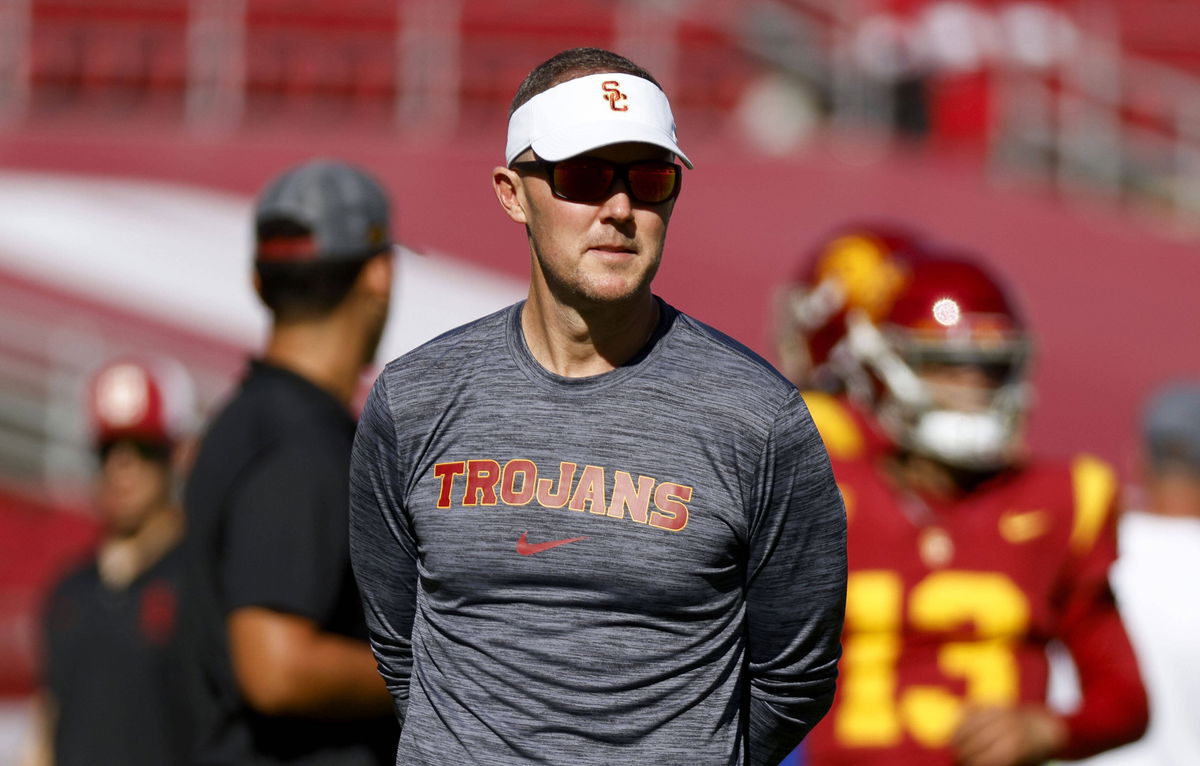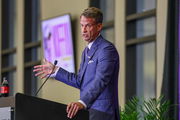
Imago
Despite an injury-hit season for USC Trojans, Lincoln Riley has led them to the top six of B1G.

Imago
Despite an injury-hit season for USC Trojans, Lincoln Riley has led them to the top six of B1G.
USC’s recruiting game under Lincoln Riley is buzzing with energy and high hopes. But a lot is riding on how well he can translate that into wins. Riley came to USC with a massive $110 million contract spread over 10 years. The Trojans had stumbled in recent years. They lost their edge in the recruiting battles, especially in Southern California, where Riley’s offensive style has a natural pull on local talent. The arrival of Chad Bowden, USC’s new GM from their arch rival, brought a fresh wave of optimism and a strategic shift to the program’s recruiting approach.
Watch What’s Trending Now!
Bowden’s experience at Notre Dame, known for its meticulous recruiting and player development, gave USC a blueprint for sustainable success rather than just chasing five-star names. He’s all about digging deeper, building relationships, and locking down the talent pipeline within California. But this confidence of the Trojans’ is hit by a roadblock when national analysts like Josh Pate question their retention capacity of these talents. “He’s not the coordinator there, he’s head coach, so you’ve got to be able to do more than just call plays and coach position. It’s about getting talent. It’s about developing the talent,” Pate said in a discussion with Colin Cowherd on his podcast.
“Now, one piece that they did was when they went and got Chad Bowden, the GM from Notre Dame. They were going to take in-state recruiting seriously.” Before Bowden, for years, the Trojans were losing top local talents to rivals like Oregon, Texas, and even SEC schools. Players from powerhouse high schools like Mater Dei and St. John Bosco were bypassing USC for programs with seemingly smoother roads to success and better NIL opportunities. Over time, this disarray translated into weaker recruiting classes and a pipeline that was drying up.
ADVERTISEMENT

ADVERTISEMENT
Bowden came in with fire in his belly and a plan to revitalize USC from the ground up. The results speak for themselves: the 2026 USC recruiting class exploded to the top of national rankings, with 32 commitments. That includes a hefty share of blue-chip in-state players. Players like receiver Ethan “Boobie” Feaster highlighted about Bowden, “my parents enjoyed him, just being around him, just as a person. Not just for his job description, but for just being around him as a person. They really did enjoy him.” And even USC’s coaching staff noticed the change. But now Pate raises a very important contradiction. “I am very interested to see whether proof of performance on the field this year is necessary to keep that class together,” Pate said.
“That’s one thing that I’m watching. The other thing, I’ve asked Chad about this. I’ve asked him, do you talk about like locking down the city, locking down the state? Do you really think there’s enough line of scrimmage talent in the state of California anymore? He said yes. I disagree with that.” The facts back this up. Recent NFL draft data shows California’s output of elite offensive and defensive linemen has declined sharply. Only about a quarter of Southern California’s draft picks come from line of scrimmage positions, much lower than Northern California. Pate is looking at a reality that doesn’t always get talked about enough.
ADVERTISEMENT
Over the years, California’s reputation as a football talent factory has remained. But the specific talent for the trenches, the O-line and D-line players USC desperately needs, has been drying up. Many of the top linemen who used to come out of powerhouse Southern California high schools are more spread out these days. Plus, a lot of these kids are being snatched up by programs outside of USC’s sphere, like Oregon, Alabama, or Texas. These schools have exploded in popularity and offer slick NIL opportunities that USC is still working to match fully. A prime example of this talent loss is Donte “Tae” Wright.
Despite strong ties to USC, his uncle played for the Trojans, and he’s just a short drive from campus, Wright chose to commit to Georgia. Even the recruits themselves are more diverse geographically. And the competition for linemen extends beyond California now because power conferences nationwide are hungry. So while USC remains committed to locking down the state, Pate sees the trench talent as a bit of a drought.
ADVERTISEMENT
Snubbed despite the 73-13 showdown?
USC’s opening game of the 2025 season was nothing short of a statement. It was a crushing 73-13 blowout of Missouri State that should have at least earned some respect nationally. But when the AP and Coaches Poll votes rolled in, USC was nowhere to be found in the Top 25. In fact, things got worse. They dropped from a No. 29 spot in the preseason Coaches Poll to 31, just outside of the rankings.
For Lincoln Riley and his team, that was a bitter pill to swallow. But this kind of snub isn’t really about one game; it’s about the narrative and skepticism still hanging over USC from last season’s defensive meltdowns and blown leads. The pollsters, the media, and even rival fans see a program still trying to prove it can live up to the Trojan name. Right now, USC’s brand is stronger than its recent results, and the polls reflect that.
Top Stories
‘RIP’: NASCAR World Crumbles in Tears as 39-YO Former JR Motorsports Driver Passes Away

Donald Trump Takes Unexpected Shot at NFL With Name Change Call During FIFA World Cup Draw

Bills Legend Jim Kelly Announces Final Cancer Update After Years of Battle

Ravens’ Lamar Jackson Demands Short-Term Contract Away From NFL on Thursday

Rory McIlroy Suffers ‘Banana Peel’ Blunder as His Australian Open Setbacks Continue

Brian Kelly Slammed For 4 Years Over Lane Kiffin’s First Move as LSU HC

They want to see USC stack wins against quality opponents. You know, like, Illinois, Notre Dame, Oregon, Michigan, before handing out serious national respect. Fans have been vocal, too. Some timing points, arguing that a clean 4-0 start could change minds. Even rival fans called out the snub as “mind-boggling.” But until the wins come against high-caliber teams, those poll snubs will keep happening.
ADVERTISEMENT
ADVERTISEMENT
ADVERTISEMENT
ADVERTISEMENT

